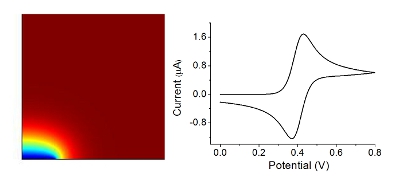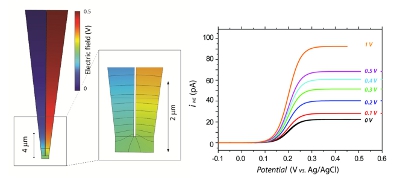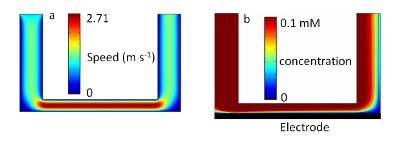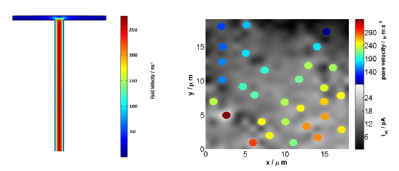Computational Modelling
- Introduction
- Scanning Electrochemical Cell Microscopy
- Channel Flow Cells and Hydrodynamics
- Membrane Studies
|
|
Finite element simulations are used to provide a theoretical framework for experiments that are too complicated to approach analytically. A simulation domain is defined with boundary conditions and internal physics based upon the experiment to be modelled. The FEM provides a means of approximating the continuous space within the domain to a finite number of points (elements). At each element the equations specified by the user are solved to provide a solution. For example Fick's 2nd Law of diffusion, in 2D-axisymmetrical co-ordinates are defined as:
In addition to providing numerical data Comsol Multiphysics can provide visual representations which are valuable for understanding the key events for understanding experimental results, or designing experiments. For example the expansion of the diffusion layer of a mediator species at a macro disc electrode when the potential is swept and the corresponding linear sweep voltammogram are shown in the figure. |
|
|
This innovative imaging technique provides a method of performing simultaneous conductometric and voltammetric studies in a confined area. The technique can be applied to a wide variety of substrates and used to probe electron transfer kinetics on conducting materials and for crystallisation/dissolution studies. Simulation of scanning electrochemical cell microscopy (SECCM) provides valuable information on the roles of diffusion and migration within the probe and for the quantification of fast heterogeneous transfer coefficients. Figure 3 shows the effect of changing the bias between the barrels on the limiting current response and the steady-state concentration profiles for a transport-limited reaction within an SECCM probe. |
|
|
The use of a controlled hydrodynamic flow over electrodes has been used to elucidate reaction pathways, reaction rates, and for enhanced sensitivity for sensors. The combination of convection and diffusion enhances mass transport to or from a substrate surface. The FEM has been used to aid the design and testing of new flow devices and to assess the impact different electrode geometries will have on the electrochemical response. Here we show the laminar convective flow through a recently designed channel flow cell, and the concentration profile when the entire channel surface acts as an electrode for a transport-limited reaction. |
|
|
Within the group a variety of semi-permeable membranes are studied. For example the transport of liquid through dentine samples has been probed by scanning electrochemical microscopy. For simulation purposes dentine can be considered a heterogeneous array of tubules that allow a restricted fluid through within an impermeable bulk material. By simulating the enhanced mass transport to the SECM probe the flow rate through individual pores can be addressed with high precision. This allows the effectiveness of blocking agents (e.g. for the treatment of sensitive teeth) to be investigated. The SECM map of a dentine surface with indentified pores and associated flow rates is shown to the left. |





